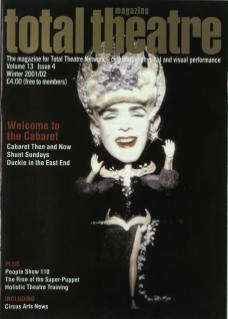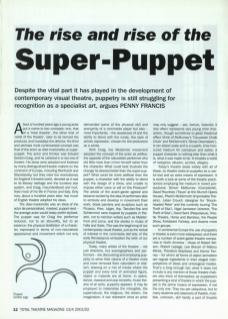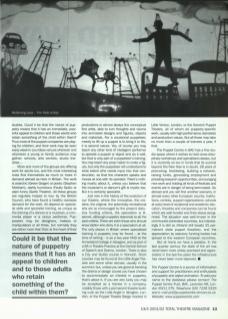About a hundred years ago a young actor put a name to two concepts: one, that of a ‘total theatre', the other that of 'artist of the theatre', later to be termed the producer, and nowadays the director. His third and perhaps most controversial concept was that of the actor as über-marionette or superpuppet. The actor and thinker was Edward Gordon Craig, and he ushered in a new era of theatre. His ideas were adopted and fostered by many distinguished theatre-makers on the continent of Europe, including Reinhardt and Stanislavsky, but they were too revolutionary for England's theatre world, devoted as it was to its literary heritage and the lucrative star system, and Craig, misunderstood and hurt, lived most of his life in France and Italy. Only now, about a hundred years later, has much of English theatre adopted his ideas.
The über-marionette was an ideal of the actor de-personalised, masked, puppet-ised – the average actor would today prefer stylised. The puppet was for Craig the performer reduced, not to an absurdity, but to an essence: the physical distillation of a character, expressed in terms of non-naturalistic appearance and movement which not only demanded some of the physical skill and anonymity of a commedia player but also – most importantly – the awareness of and the ability to blend with the mode, the style of artistic expression, chosen for the production as a whole.
With Craig, the Modernist movement adopted the concept of the actor as artifice, the opposite of the naturalistic performer who did little more than mirror himself rather than the character. What could best illustrate the change he desired better than the super-puppet? What could be more artificial than the puppet, a character with the ability to blend with the design of a show, and unable to impose either voice or will on the Producer? The artists of the avant-garde agreed and became excited by the idea of performers able to embody and develop in movement their work. Great painters and sculptors such as Picasso, Klee, Léger, Arp, Taeuber-Arp and Schlemmer were inspired by puppets in theatre, not to mention writers such as Maeterlinck and Lorca, and the stories in music of Falla and Satie. This was the beginning of our contemporary visual theatre, just as the revival of interest in the commedia dell'arte of the early Renaissance embodied the birth of our physical theatre.
Today, many artists of the theatre – not just directors, but scenographers and performers – are discovering and employing puppetry to serve their visions of a theatre more and more removed from naturalism or realism; drawing on a mix of media where the puppet and every kind of animated figure, object or material are at home. In opera, dance, classical and pop concerts, music theatre of all sorts, puppetry appears. It may be employed to materialise the intangible, the supernatural, the religious, the dream, the imagination; it can represent what an actor may only suggest – sex, torture, violence; it (too often) represents very young child characters, though sometimes to great theatrical effect (think of McBurney's ‘Caucasian Chalk Circle' and McDermott's 'Ghost Downstairs'). It can distort scale and is a superb, time-honoured medium for caricature and satire. A puppet character is nothing else than what it is, what it was made to be. It inhabits a world of metaphor, allusion, symbol, allegory.
Today's theatre deals widely with all of these, so theatre looks to puppetry as a useful tool and an extra means of expression. It is worth a look at some of the theatre practitioners employing the medium in recent productions: Simon McBurney (Complicité), David Pountney (Faust at the Munich Opera House), Phelim McDermott (Improbable Theatre), Julian Crouch (designer for Shockheaded Peter and the currently touring The Theft of Sita), Nigel Jamieson (director, The Theft of Sita), David Sant (Peepolykus), Trestle Theatre, Horse and Bamboo, the People Show, Forkbeard Fantasy, and dozens more such groups.
In continental Europe the use of puppetry in theatre is even more widespread, and there are a number of avant-garde theatre companies in North America – those of Robert Wilson, Robert Lepage, Lee Breuer of Mabou Mines, Theodora Skipitares and Hanne Tierney – for whom all forms of object animation are regular ingredients in their staged interpretations of ideas and ontological modes. That's a long enough list: what it does not include is any mention of those theatre-makers who think of themselves as puppeteers presenting a kind of theatre in which the puppet is the prime means of expression, if not the only one. They too are ubiquitous, but to many students and observers of theatre, invisible, unknown, still hardly a part of theatre studies. Could it be that the nature of puppetry means that it has an immediate, powerful appeal to children and those adults who retain something of the child within them? Thus most of the puppet companies are playing for children, and their work may be seen every week in countless venues wherever and whenever a young or family audience may gather: schools, arts centres, studio theatres...
More and more of the groups are offering work for adults too, and the most interesting ones find themselves as much or more in demand abroad as here in Britain. The work is anarchic (Green Ginger) or poetic (Stephen Mottram), darkly humorous (Faulty Optic) or plain funny (Garlic Theatre). All these groups are regularly helped to tour by the British Council, who have found a healthy overseas demand for the work. All depend on specialist skills and specialist training, as unique as the training of a dancer or a musician, a commedia player or a circus performer. Puppeteers may be designers, makers or manipulators or all three, but normally they are rather more than that: at the heart of their productions is almost always the conceptual fine artist, able to turn thoughts and visions into animated designs and figures, objects and materials. For a vocational puppeteer, merely to lift up a puppet is to bring it to life; it is second nature. Yes, of course you may teach any other kind of intelligent performer to operate a puppet or object and do it well, but that is only part of a puppeteer's training. You may teach any prop-maker to make a figure, but only the puppeteer will understand to what extent she needs input into that construction, so that the character speaks and moves at one with its operator. There's nothing mystic about it, unless you believe that the musician's or dancer's gift is mystic too. But it is certainly specialist.
Just now in the history of the evolution of our theatre, where the innovative, the creative, the original, the potentially recreational arts are so encouraged by the present statutory funding criteria, the specialism is ill-served, although puppetry responds to all the said criteria. There are even those who should know better who deny it is a specialism at all. The only places in Britain where specialised training in puppetry may be found at the time of writing is as a two-year HND at the Anniesland College in Glasgow; and as part of a BA in Theatre Practice at the Central School of Speech and Drama, London. There is also a City and Guilds course in Norwich. Short courses may be found at the Little Angel Theatre and some other venues, usually in the summer; but, unless you are good at bending the drama or design course you have chosen to accommodate an interest in puppetry, that's about it. If you are very lucky you may be accepted as a trainee in a company, notably those with a permanent theatre building such as the Little Angel in Islington, London, or the Puppet Theatre Barge moored in Little Venice, London, or the Norwich Puppet Theatre, all of whom do puppetry-specific work, usually with high performance standards and production values. But all these may take no more than a couple of trainees a year, if that.
The Puppet Centre in BAC has a fine studio space where it wishes to hold cross-disciplinary workshops and specialised classes, but it is currently so low in funds that its survival beyond the New Year is in doubt. 26 years of promoting, facilitating, building a network, raising funds, generating employment and providing research opportunities, encouraging new work and holding all kinds of festivals and events are in danger of being terminated. Go abroad and you will find another scenario, in almost every other European country. Institutions, centres, support organisations, schools at every level of vocational and academic education, theatres and companies can be found which are well-funded and their status recognised. The situation was well-known in the communist-controlled countries, but interestingly it is still so (Poland still boasts 25 permanent state puppet theatres), and the appreciation by statutory funding bodies has spread to the western European countries.
But at home we have a paradox. In the last quarter century the state of the art has never been more widely practised and appreciated; in the last five years the infrastructure has never been more deprived.
The Puppet Centre is a source of information and support for practitioners and enthusiasts of puppetry and object animation. www.puppetcentre.com


